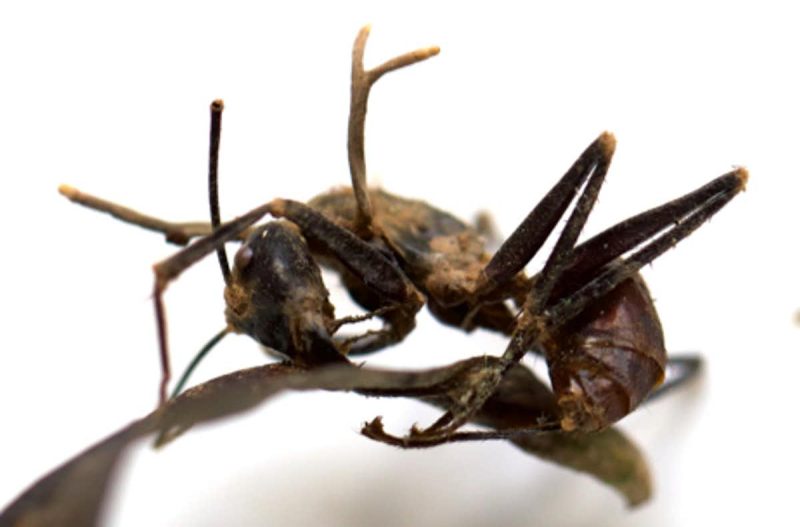Cordyceps growing out of an ant’s head. Via BBC/GIPHY.
By Gino Brignoli, UCL
In the understory of a tropical forest, a carpenter ant has descended from the canopy away from her regular foraging trails and staggers drunkenly along a branch. Her movements are jerky and conspicuous. She twitchily moves forwards and suddenly starts convulsing with such ferocity that she falls from the branch onto the ground before resuming her erratic, zigzagging path. This is a “zombie ant”, and she’s unwittingly become part of the lifecycle of a parasitic fungus commonly known as Cordyceps.
Around noon, after several hours of climbing and aimless lurching, the ant is now no more than about 10 inches (25 cm) above the ground, crawling aimlessly on the underside of a sapling leaf where, without warning, she forcefully sinks her powerful jaws into one of the leaf’s veins, gripping it firmly between her tightly locked mandibles.
Within six hours, she is dead. After two days, white hairs bristle from between her joints and a few days later these have become a thick, brown mat covering the whole insect. A pinkish-white stalk starts to erupt from the base of the ant’s head and continues to grow. Within two weeks it has reached twice the length of the ant’s body reaching down towards the ground below.
Finally, the stalk will release its spores into the air, ready to float off and infect more unsuspecting ants.

This bizarre behavior was first recorded by Alfred Russell Wallace in Indonesia in 1859, but was not researched in much detail until quite recently. It has since been discovered that the fungus disrupts the normal behavior of the ant through chemical interference in the brain, causing the infected ant to behave in ways that will improve the opportunities for the fungus to spread its spores and so reproduce.
The fungus grows throughout the body cavity of the ant, using internal organs as food while the ant’s strong exoskeleton serves as a kind of capsule, protecting the fungus from drying out, being eaten, or further infection.
Fending off the fungi
The earliest known record of a fungus visibly parasitizing an insect dates from about 105m years ago. It is a male scale insect, preserved in amber, with two fungal stalks projecting from its head. But this fossil cannot tell us if the infected insect’s regular behavior was changed or disrupted in any way.

Definitive evidence of “zombie-ant” behavior, dating to around 48m years ago, comes from fossilized leaves that show the distinct markings on either side of leaf veins left by the lock-jawed mandibles of infected ants. Not only is this association between ant and fungus evidently ancient, it is also very common – about 1,000 species of fungal parasites of insects have been discovered so far.
In this age-old struggle for survival the ants have developed adaptations to protect themselves and their nests from fungal infections. By grooming themselves and socially cleaning each other (allogrooming) they remove potentially harmful spores before they can penetrate the skin and take hold. Some ants spray poison in their nests to act as fungicides and if that fails to stop an infestation, they partition their nests by sealing off contaminated chambers.
In some cases infected individuals are carried out of the nest by healthy workers, and as a last resort the entire colony relocates, abandoning their infected nest.
The fungal pathogens have evolved to become either strictly species-specific or more generalist in their choice of insect host, with some able to infect hundreds of different species. This astonishing variety of fungal pathogens and potential hosts has created some peculiar behavior in insects as they have co-evolved to cope with the tactics of the fungi.
It is sometimes difficult to know what behavior is entirely involuntary and driven by the fungus to improve its own reproductive success, and what has evolved as a form of defense against the infection. For example, when the ant host climbs to an elevated position in what is known as “summit disease,” this behavior increases the area over which spores can spread through wind dispersal – but it also removes the ant from close proximity to its relatives in the colony, preventing the spread of infection to its sisters.
It is unclear if this behavior is a zombie state caused by the fungus or if it is an altruistic act of self-sacrifice by the ant. If it is a deliberate act by the ant, it might be saving the rest of the colony from succumbing to the infection in what is sometimes called “adaptive suicide.”
Zombie-like behavior in insects is also caused by many other types of parasites including bacteria and even other invertebrates. This raises fascinating questions about the nature of any organism’s true independence in what are undoubtedly highly complex interrelated living systems. Zombie ants provide us with a glimpse into this intricately tangled web of molecular influences and behavioral adaptations. It leads us to wonder who, ultimately, controls whom?
Gino Brignoli, Ph.D. Researcher in tropical ecology at the Institute of Zoology and UCL
This article is republished from The Conversation under a Creative Commons license. Read the original article.
Bottom line: A parasitic fungus takes control of living insects, turning them into “zombie ants.”
![]()











